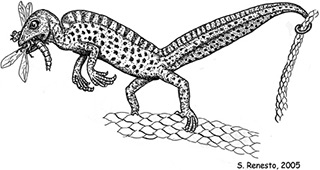
Drepanosauromorpha
The "monkey lizards"
Imagine an animal the size of a cat, with a long, heavy body like an iguana, grasping hands and feet like a chameleon, a bony ridge over its shoulders, a thin neck and a small, pointed head, like a plucked chicken, and a long prehensile tail, like a spider monkey—only with a claw on the end. With features seemingly drawn at random from evolution's spare parts box, drepanosaurs look more invented than real. But these tree-climbing insectivores actually existed in the Late Triassic, and although their fossils are rare, they show that the group was widespread in the northern supercontinent of Laurasia.
Drepanosaurs are still relatively new to science. The first specimens were described in 1980, but these strange animals were not recognized as a distinct group until 1992. There are currently five known drepanosaurs:
| Drepanosaur | Described | From |
|
Drepanosaurus Megalancosaurus Dolabrosaurus Hypuronector Vallesaurus |
1980 1980 1992 2001 2010 |
Italy Italy New Mexico New Jersey Italy |
|
In general, drepanosaurs are characterized by:
Drepanosaurus itself is unusual in having a huge claw on the index finger of each hand. The skull of Drepanosaurus is unknown, but if it was built like that of Megalancosaurus, then each hand claw was probably about the same size as the animal's entire head! Hypuronector differs from other drepanosaurs in having an extremely deep, narrow tail that was almost certainly not prehensile. All of the drepanosaurs are small, less than 50 cm long; and at a mere 18 cm (~7 inches), Hypuronector could sit in the palm of your hand. Skull material has only been described for Megalancosaurus, Hypuronector and Vallesaurus. Megalancosaurus has very small teeth in its otherwise birdlike jaws. Only the lower jaw is known from Hypuronector. It had large teeth toward the back of its mouth, but the front half of the jaw is modified into a pointed, toothless beak. |
 A skeletal restoration of Drepanosaurus (the skull has not been found) clearly illustrates the oversize claw on the hand. |
Systematics
From the beginning, drepanosaurs have been a challenge to classify. Most specimens are incomplete and flattened into two dimensions, and their anatomy is so bizarre that paleontologists sometimes disagree about which bones are which. The first problem was recognizing that drepanosaurs represent a distinct clade of organisms. As more drepanosaurs were discovered, it became easier to recognize the similarities between them. The most striking similarities are in the tall, narrow tails and unusual vertebrae. Two names have been proposed for the clade that unites all known drepanosaurs: Simiosauria, the "monkey lizards," and Drepanosauromorpha.
 This reconstruction pictures Vallesaurus as an arboreal insectivore. |
Ecology
The life habits of drepanosaurs have been almost as contentious as their relationships. Based on the huge hand claws, Drepanosaurus was originally characterized as a digger. All drepanosaurs have fairly deep tails, and the tail of Hypuronector is especially paddle-like, so they have often been thought to be semiaquatic swimmers. However, the grasping feet and claw-tipped tails are much more similar to those of arboreal animals. Hypuronector's deep tail was probably not very flexible and would have made a poor paddle, and its long limbs are very different from those of animals that are specialized for a life in water. Drepanosaurs probably lived in trees and ate insects. Drepanosaurus may have used its big claws to rip open bark to find grubs and beetles. The deep tail of tiny Hypuronector is roughly leaf-shaped, and may have been used for camouflage.
Dr. Silvio Renesto has done more work on more drepanosaurs than anyone else. You can find photos and drawings of the Italian taxa at his webpage. The Hairy Museum of Natural History has a cool page on drepanosaurs, with skeletal diagrams, life restorations, and links to other resources.
Sources
|
||
Text by Matt Wedel, 5/2007. Megalancosaurus, Drepanosaurus and Vallesaurus illustrations courtesy of Silvio Renesto, University of Insubria, Italy.